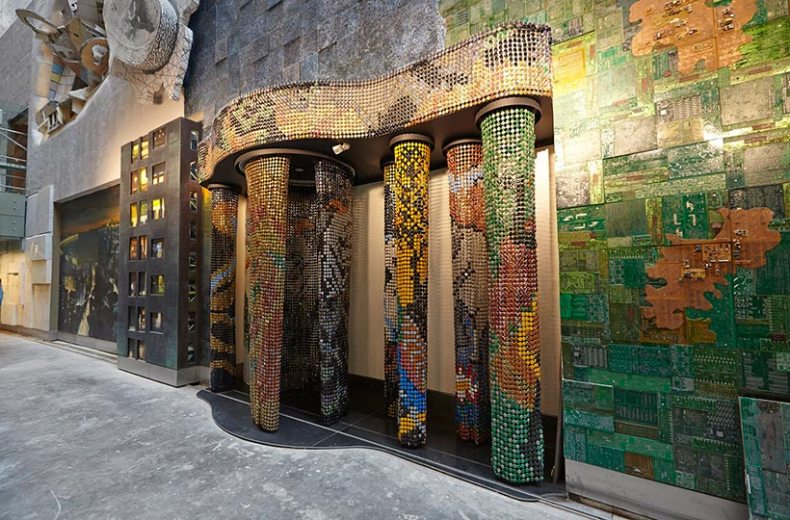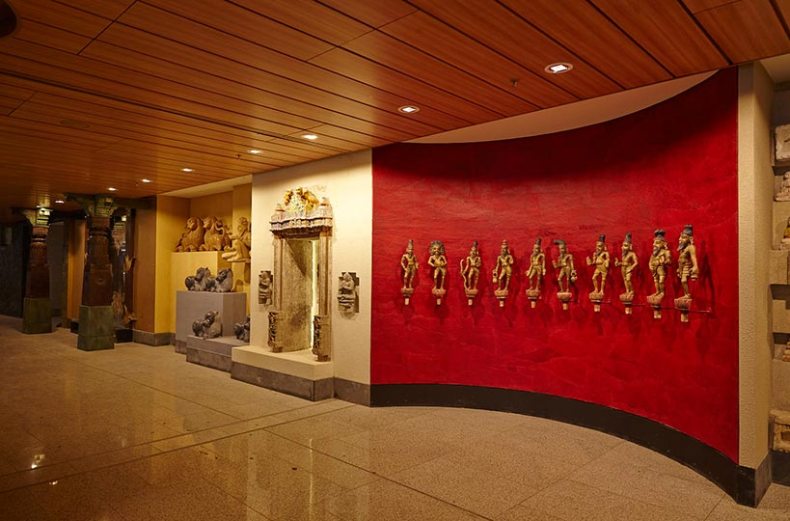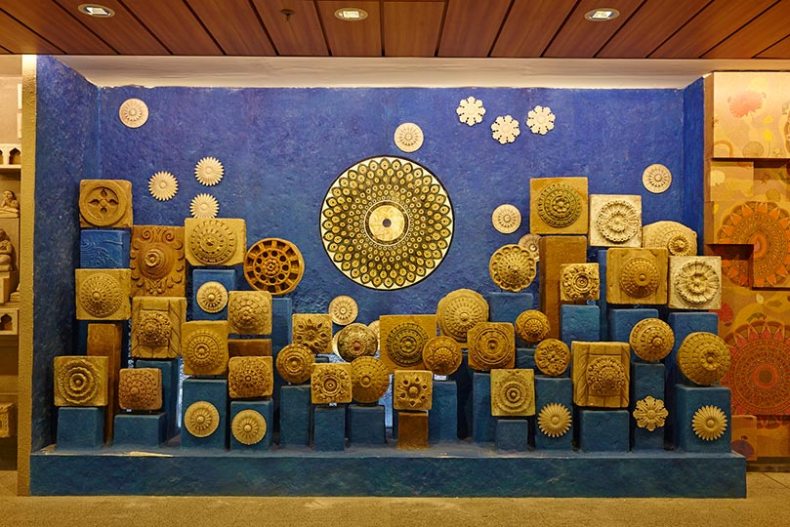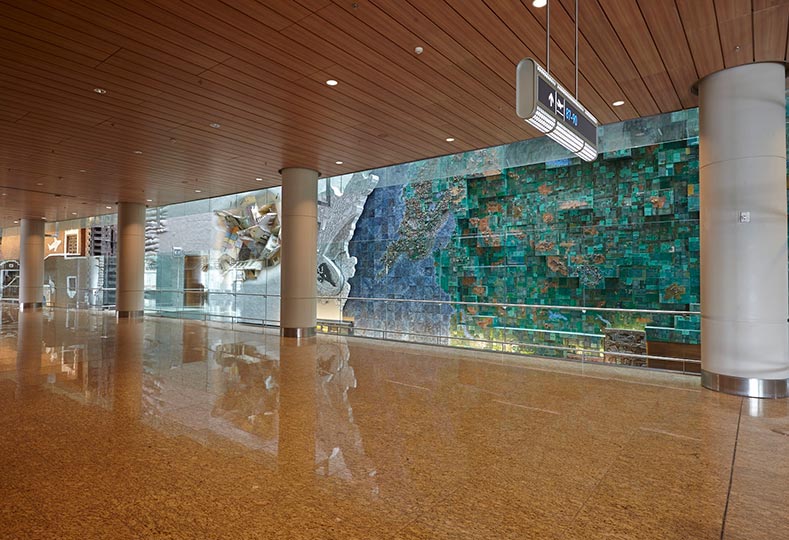Cultural impresario Rajeev Sethi is creating probably the world’s most art-filled and interesting airport, Terminal 2 at Chhatrapati Shivaji International Airport in Mumbai, India’s financial and entertainment capital. Inside Skidmore, Owings & Merrill’s building, which opened on February 12 and includes a wall of lights inspired by temple oil lamps, every one of the expected annual 40 million passengers will encounter thousands of historic and contemporary art works including (looking ahead), a white automated peacock puppet flying a circle on the hour.

Heptad the 7th, SharmilaSamant
Sethi is a man of contagious enthusiasm even in the hectic week leading up to the opening. He moves between T2, as the building is already nicknamed, and a nearby warehouse-sized art store-cum-studio, just occasionally sleeping in his bed at the nearby Grand Hyatt hotel where he commissioned the three floors of site specific art inspired by Mumbai’s Elephanta Cave. He believes India is so rich in historic art and living artists that ‘the whole country is a living museum. We live in so many centuries at the same time.’ Sethi has conceived the single largest installation of approximately 80000 sq ft, and further displays across the airport. He envisages T2 as a new kind of public museum and art forum.
To start with, he gathered a young team and went on a two-year shopping spree across India with Sanjay Reddy of GVK, the terminal’s developer. They scooped up huge wooden totems from tribal Nagaland in the north-east, painted masks from a store in Kerala, entire carved façades of traders’ homes in coastal Gujarat, and much more. More than 100 restorers then got to work to mend, conserve and prepare each piece for its location. ‘We did everything a museum would do’, says Sethi.

Wooden saints bless travellers on their journey at the Bus Lounge area 2 © India greets
Sethi also commissioned artists and craftsmen – for him they are one and the same – to work with the historic pieces or create new pieces. They gave iPhones to some of them to document the creation process, and these 5–7 minute-long films will be both online and accessible to visitors by clicking on the artworks’ signage.
Sethi shows me an exquisitely carved wooden verandah that will have a contemporary installation of an ethereal woman weaving in and out of the columns: ‘It’s about the spirit of inside and out, neither here or there, like an airport.’ For another house façade, the artist Prayas has created and installed cameras inside the shutters that photograph passengers passing by and project their faces fluttering randomly back onto the façade. In the arrivals hall, 30 murals include a kinetic installation using work by the Gond tribals of Central India.

Carved lotuses of varied sizes and designs
To give an idea of the vast scale of the project, its centrepiece is a gigantic art wall four floors high, whose total length is over three kilometres. One section of it is devoted to installations created with traditional craftsmen from Rajasthan, Bengal, Kashmir and Kerala.’ Sethi grins: ‘It’s like having too many desserts together!’
 Mumbai is a city that the British and local traders and craftsmen together made ‘Urbs prima in India’ in the 19th century, giving it monumental Victorian Gothic civic buildings that outstrip those in London. Over the past two decades, Mumbai has been the torch-bearer for quality building restoration, from the university’s convocation hall to the Dr Bhau Daji Lad Museum. Now, in stark contrast to the capital Delhi’s dreary new airport which opened in 2010, T2 endorses Mumbai’s position as India’s most dynamic city.
Mumbai is a city that the British and local traders and craftsmen together made ‘Urbs prima in India’ in the 19th century, giving it monumental Victorian Gothic civic buildings that outstrip those in London. Over the past two decades, Mumbai has been the torch-bearer for quality building restoration, from the university’s convocation hall to the Dr Bhau Daji Lad Museum. Now, in stark contrast to the capital Delhi’s dreary new airport which opened in 2010, T2 endorses Mumbai’s position as India’s most dynamic city.

Art in the Airport: Terminal 2 Mumbai
Share
Cultural impresario Rajeev Sethi is creating probably the world’s most art-filled and interesting airport, Terminal 2 at Chhatrapati Shivaji International Airport in Mumbai, India’s financial and entertainment capital. Inside Skidmore, Owings & Merrill’s building, which opened on February 12 and includes a wall of lights inspired by temple oil lamps, every one of the expected annual 40 million passengers will encounter thousands of historic and contemporary art works including (looking ahead), a white automated peacock puppet flying a circle on the hour.
Heptad the 7th, SharmilaSamant
Sethi is a man of contagious enthusiasm even in the hectic week leading up to the opening. He moves between T2, as the building is already nicknamed, and a nearby warehouse-sized art store-cum-studio, just occasionally sleeping in his bed at the nearby Grand Hyatt hotel where he commissioned the three floors of site specific art inspired by Mumbai’s Elephanta Cave. He believes India is so rich in historic art and living artists that ‘the whole country is a living museum. We live in so many centuries at the same time.’ Sethi has conceived the single largest installation of approximately 80000 sq ft, and further displays across the airport. He envisages T2 as a new kind of public museum and art forum.
To start with, he gathered a young team and went on a two-year shopping spree across India with Sanjay Reddy of GVK, the terminal’s developer. They scooped up huge wooden totems from tribal Nagaland in the north-east, painted masks from a store in Kerala, entire carved façades of traders’ homes in coastal Gujarat, and much more. More than 100 restorers then got to work to mend, conserve and prepare each piece for its location. ‘We did everything a museum would do’, says Sethi.
Wooden saints bless travellers on their journey at the Bus Lounge area 2 © India greets
Sethi also commissioned artists and craftsmen – for him they are one and the same – to work with the historic pieces or create new pieces. They gave iPhones to some of them to document the creation process, and these 5–7 minute-long films will be both online and accessible to visitors by clicking on the artworks’ signage.
Sethi shows me an exquisitely carved wooden verandah that will have a contemporary installation of an ethereal woman weaving in and out of the columns: ‘It’s about the spirit of inside and out, neither here or there, like an airport.’ For another house façade, the artist Prayas has created and installed cameras inside the shutters that photograph passengers passing by and project their faces fluttering randomly back onto the façade. In the arrivals hall, 30 murals include a kinetic installation using work by the Gond tribals of Central India.
Carved lotuses of varied sizes and designs
To give an idea of the vast scale of the project, its centrepiece is a gigantic art wall four floors high, whose total length is over three kilometres. One section of it is devoted to installations created with traditional craftsmen from Rajasthan, Bengal, Kashmir and Kerala.’ Sethi grins: ‘It’s like having too many desserts together!’
Unlimited access from just $16 every 3 months
Subscribe to get unlimited and exclusive access to the top art stories, interviews and exhibition reviews.
Share
Recommended for you
Germany proposes a new law to enable the return of looted art
If passed, the law would remove a significant barrier for families trying to recover Nazi-looted items
Augmented Reality Meets the Art World
It was only a matter of time before the art world went virtual…
Packing Up: MoMA’s plans for the Folk Museum’s façade
Looking at the two museums side by side – which one do you think looks more radical?